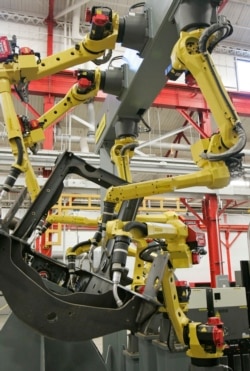A report says the number of robots being used in workplaces across the United States doubled from 2009 to 2017.
Most of the robots worked in manufacturing operations across America’s Midwest, the report said. It noted that the effect robots had on manufacturing job losses was lessened by economic growth that followed the last major U.S. recession.
The report comes from the Century Foundation research group, which is based in New York City.
William M. Rodgers III is a professor of public policy and chief economist at the Heldrich Center for Workforce Development at Rutgers University in New Jersey. He co-wrote the report. It examines how workplace robots are affecting U.S. workers and their pay.
“A growing economy independent of technology, independent of robotics, has been able to absorb, at least at the national level ... people who may have gotten displaced,” Rodgers told VOA.
Some Midwest states have twice as many robots as all other U.S. areas and have suffered from the rise in robot workers, the report found. Michigan, Ohio, Indiana, Illinois and Wisconsin have the highest levels of working robots, mostly in manufacturing businesses.
Industrial robots generally perform jobs that do not change much from day to day. These include putting things together, loading products, welding or painting.
The report found that the workers most affected by the machine takeover are young people. They also had less education than other workers. Black men and women experienced the greatest job losses.
Rodgers noted that U.S. workers who change jobs and find themselves employed in different industries often have to settle for lower pay. This can also be a problem when large job displacements lead to an oversupply of workers in some industries.
“If demand for workers is not growing fast enough, you begin to see a decline in wages,” he added.
Rodgers called on employers to develop better ways to help the displaced workers. If the right solutions are found, he said, some workers pushed out by robots can actually end up getting higher-paid positions. Assistance programs should include education and training programs to help prepare people for new career paths.
Rodgers added that now is the best time to prepare for the rise of the robots.
“What better time to be able to help people who are getting bullied, so to speak, by technology. Or getting bullied, so to speak, by globalization,” he said. “Times of prosperity is the best time... to invest in all Americans.”
I’m Bryan Lynn.
Dora Mekouar reported this story for VOA News. Bryan Lynn adapted the report for Learning English. George Grow was the editor.
We want to hear from you. Write to us in the Comments section, and visit our Facebook page.
_________________________________________________________________
Words in This Story
absorb – v. take something in
weld – v. join pieces of metal together by heating them and pressing them together
decline – v. refuse something
bully – v. purposely frighten someone who is smaller or weaker than you
prosperity – n. situation in which someone is successful and earns a lot of money










